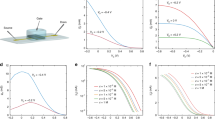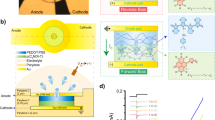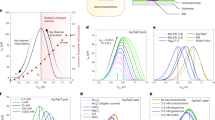Abstract
Real-time stimulation and recording of neural cell bioelectrical activity could provide an unprecedented insight in understanding the functions of the nervous system, and it is crucial for developing advanced in vitro drug screening approaches. Among organic materials, suitable candidates for cell interfacing can be found that combine long-term biocompatibility and mechanical flexibility. Here, we report on transparent organic cell stimulating and sensing transistors (O-CSTs), which provide bidirectional stimulation and recording of primary neurons. We demonstrate that the device enables depolarization and hyperpolarization of the primary neuron membrane potential. The transparency of the device also allows the optical imaging of the modulation of the neuron bioelectrical activity. The maximal amplitude-to-noise ratio of the extracellular recording achieved by the O-CST device exceeds that of a microelectrode array system on the same neuronal preparation by a factor of 16. Our organic cell stimulating and sensing device paves the way to a new generation of devices for stimulation, manipulation and recording of cell bioelectrical activity in vitro and in vivo.
This is a preview of subscription content, access via your institution
Access options
Subscribe to this journal
Receive 12 print issues and online access
$259.00 per year
only $21.58 per issue
Buy this article
- Purchase on Springer Link
- Instant access to full article PDF
Prices may be subject to local taxes which are calculated during checkout





Similar content being viewed by others
References
Poghossian, A., Ingerbrandt, S., Offenhäusser, A. & Schöning, M. J. Field- effect devices for detecting cellular signals. Semin. Cell. Dev. Biol. 20, 41–48 (2009).
Johnstone, A. F. M. et al. Microelectrode arrays: A physiologically based neurotoxicity testing platform for the twenty first century. NeuroToxicology 31, 331–350 (2010).
Novellino, A. et al. Development of micro-electrode array based tests for neurotoxicity: assessment of interlaboratory reproducibility with neuroactive chemicals. Front. Neuroeng. 4, 1–14 (2011).
Nam, Y. & Wheeler, B. C. In vitro microelectrode array technology and neural recordings. Crit. Rev. Biomed. Eng. 39, 45–61 (2011).
Offenhäusser, A., Sprössler, C., Matsuzawa, M. & Knoll, W. Field-effect transistor array for monitoring electrical activity from mammalian neurons in culture. Biosens. Bioelectron. 12, 819–826 (1997).
Brüggemann, D. et al. Nanostructured gold microelectrodes for extracellular recording from electrogenic cells. Nanotechnology 22, 265104 (2011).
Fromherz, P., Offenhäusser, A., Vetter, T. & Weis, J. A neuron-silicon junction: a retzius cell of the leech on an insulated-gate field-effect transistor. Science 252, 1290–1293 (1991).
Besl, B. & Fromherz, P. Transistor array with an organotypic brain slice: field potential records and synaptic currents. Eur. J. Neurosci. 15, 999–1005 (2002).
Voelker, M. & Fromherz, P. Signal transmission from individual mammalian nerve cell to field-effect transistor. Small 1, 206–210 (2005).
Eickenscheidt, M., Jenkner, M., Thewes, R., Fromherz, P. & Zeck, G. Electrical stimulation of retinal neurons in epiretinal and subretinal configuration using a multicapacitor array. J. Neurophysiol. 107, 2742–55 (2012).
Cohen-Karni, T., Timko, B. P., Weiss, L. E. & Lieber, C. M. Flexible electrical recording from cells using nanowire transistor arrays. Proc. Natl Acad. Sci. USA 106, 7309–7313 (2009).
Patolsky, F. et al. Detection, stimulation and inhibition of neuronal signals with high-density nanowire transitor arrays. Science 313, 1100–1104 (2006).
Duan, X. et al. Intracellular recordings of action potentials by an extracellular nanoscale field-effect transistor. Nature Nanotech. 7, 174–179 (2012).
Voskerician, G. et al. Biocompatibility and biofouling of MEMS drug delivery devices. Biomaterials 24, 1959–1967 (2003).
Sirringhaus, H. Device physics of solution-processed organic field-effect transistors. Adv. Mater. 17, 2411–2425 (2005).
Mabeck, J. T. & Malliaras, G. G. Chemical and biological sensors based on organic thin-film transistors. Anal. Bionanl. Chem. 384, 343–353 (2006).
Muccini, M. A bright future for organic field-effect transistors. Nature Mater. 5, 605–613 (2006).
Bystrenova, E. et al. Neural networks grown on organic semiconductors. Adv. Funct. Mater. 18, 1751–1756 (2008).
Cramer, T. et al. Organic ultra-thin film transistors with a liquid gate for extracellular stimulation and recording of electric activity of stem cell-derived neuronal networks. Phys. Chem. Chem. Phys. 15, 3897–3905 (2013).
Ghezzi, D. et al. A hybrid bioorganic interface for neuronal photoactivation. Nature Commun. 166, 1–7 (2011).
Margineanu, A. et al. Visualization of membrane rafts using a perylene monoimide derivative and fluoresecnce lifetime imaging. Biophys. J. 93, 2877–2891 (2007).
Zhao, Y. et al. Water-soluble 3,4:9,10-perylene tetracarboxylic ammonium as a high-performnance fluorochrome for living cells staining. Luminescence 24, 140–143 (2009).
Hak Oh, J. et al. Air-stable n-channel organic thin-film transistors with high field-effect mobility based on N, N′-bis(heptafluorobutyl)-3,4:9,10-perylene diimide. Appl. Phys. Lett. 91, 212107 (2007).
Dinelli, F. et al. High-mobility ambipolar transport in organic light-emitting transistors. Adv. Mater. 18, 1416–1420 (2006).
Melli, G. & Höruk, R. Dorsal root ganglia sensory neuronal cultures: A tool for drug discovery for peripheral neuropathies. Expert. Opin. Drug Discov. 4, 1035–1045 (2009).
Corcoran, J. & Maden, M. Nerve growth factor acts via retinoic acid synthesis to stimulate neurite outgrowth. Nature Neurosci. 2, 307–308 (1999).
Hodgkinson, G. N., Tresco, P. A. & Hlady, V. The role of well-defined patterned substrata on the regeneration of DRG neuron pathfinding and integrin expression dynamics using chondroitin sulphate proteoglycans. Biomaterials 33, 4288–4297 (2012).
Benfenati, V. et al. Biofunctional silk/neuron interfaces. Adv. Funct. Mater. 22, 1871–1884 (2012).
Wood, M. D. & Willits, R. K. Applied electric field enhances DRG neurite growth: Influence of stimulation media, surface coating and growth supplements. J. Neural Eng. 6, 046003 (2009).
Singh, R. P., Cheng, Y. H., Nelson, P. & Zhou, F. C. Retentive multipotency of adult dorsal root ganglia stem cells. Cell Transplant. 18, 55–68 (2009).
Van der Zee, C. E. E. M. et al. Expression of growth-associated protein B-50 (GAP43) in dorsal root ganglia and sciatic nerve during regenarative sprouting. J. Neurosci. 9, 3505–3512 (1989).
Zhang, Q. & Tan, Y. Nerve growth factor augments neuronal responsiveness to noradrenaline in cultured dorsal root ganglion neurons of rats. Neuroscience 193, 72–9 (2011).
Xie, W., Strong, J. A. & Zhang, J. M. Increased excitability and spontaneous activity of rat sensory neurons following in vitro stimulation of sympathetic fibre sprouts in the isolated dorsal root ganglion. Pain 151, 447–59 (2010).
Kitamura, N., Konno, A., Kuwahara, T. & Komagiri, Y. Nerve growth factor-induced hyperexcitability of rat sensory neuron in culture. Biomed. Res. 26, 123–30 (2005).
Schoen, I. & Fromherz, P. Extracellular stimulation of mammalian neurons through repetitive activation of Na+ channels by weak capacitive currents on a silicon chip. J. Neurophysiol. 100, 346–357 (2008).
Ulbricht, W. Sodium channel inactivation: Molecular determinants and modulation. Physiol. Rev. 85, 1271–301 (2005).
Fromherz, P. Nanoelectronics and Information Technology 781–810 (Wiley, 2003).
Khine, M. et al. A single cell electroporation chip. Lab Chip 5, 38–43 (2005).
Bräuner, T., Hülser, D. F. & Strasser, R. J. Comparative measurements of membrane potentials with microelectrodes and voltage-sensitive dyes. Biochim. Biophys. Acta 771, 208–16 (1984).
González, J. E. & Tsien, R. Y. Improved indicators of cell membrane potential that use fluorescence resonance energy transfer. Chem. Biol. 4, 269–77 (1997).
Bove, M., Grattarola, M., Martinoia, S. & Verreschi, G. Interfacing cultured neurons to planar substrate microelectrodes: characterization of the neuron-to-microelectrode junction. Bioelectr. Bioenerget. 38, 255–265 (1995).
Heal, R. D., Rogers, A. T., Lunt, G. G., Pointer, S. A. & Parsons, A. T. Development of a neuronal pressure sensor. Biosens. Bioelectron. 16, 905–909 (2001).
Tripathi, P. K. et al. Analysis of the variation in use-dependent inactivation of high-threshold tetrodotoxin-resistant sodium currents recorded from rat sensory neurons. Neuroscience 143, 923–938 (2006).
Maccione, A. et al. A novel algorithm for precise identification of spikes in extracellularly recorded neuronal signals. J. Neurosci. Methods 177, 241–249 (2009).
Shahaf, G. & Marom, S. Learning in networks of cortical neurons. J. Neurosci. 21, 8782–8788 (2001).
Roberts, M. E. et al. Water-stable organic transistors and their application in chemical and biological sensors. Proc. Natl Acad. Sci. USA 105, 12134–12139 (2008).
Kuribara, K. et al. Organic transistors with high thermal stability for medical applications. Nature Commun. 3, 723–738 (2012).
Hamil, O. P., Marty, A., Neher, E., Sakmann, B & Sigworth, F. J. Improved patch-clamp techniques for high-resolution current recording from cells and cell-free membrane patches. Pflugers Arch. 391, 85–100 (1981).
Acknowledgements
Financial support by Consorzio MIST E-R through Programma Operativo FESR 2007-2013 della Regione Emilia-Romagna– Attività I.1.1., MIUR through project PRIN 2009- 2009AZKNJ7 and EU FP7 Marie Curie ITN-316832 project OLIMPIA are acknowledged. We are grateful to P. Mei and T. Bonfiglioli from CNR-ISMN and to V. Biondo and R. D’Alpaos from E.T.C. for their valuable technical contribution. S. Ferroni and M. Caprini (for comments on the work), and A. Minardi (for DRG cell culture preparation), from the Department of Human and General Physiology of the University of Bologna, are gratefully acknowledged.
Author information
Authors and Affiliations
Contributions
V.B. defined the concept of the O-CST device, cultured DRG neurons, performed patch-clamp and optical read-out experiments, extracellular recording experiments, analysed and interpreted results. S.T. defined the concept of the O-CST device, performed optical imaging and optical read-out experiments, extracellular recording experiments, analysed and interpreted results. S.B. performed O-CST and MEA measurements. G.T. contributed to the fabrication of OFET devices and performed electrical measurements. A.P. prepared DRG cell culture and performed cell viability assays. M.C. performed elaboration and statistical analysis of O-CST and MEA data. A. Sagnella contributed to the fabrication of the OFET devices. A. Stefani contributed to the fabrication of the OFET devices. G.G. contributed to the fabrication of the OFET devices and performed electrical measurements. G.R. discussed and interpreted results. D.S. performed simulation of the O-CST device electric field and electrostatic potential. R.Z. discussed the concept of the O-CST device. M.M. defined the concept of the O-CST device, discussed and interpreted results, coordinated and supervised the entire work and wrote the manuscript.
Corresponding authors
Ethics declarations
Competing interests
The authors declare no competing financial interests.
Supplementary information
Supplementary Information
Supplementary Information (PDF 1025 kb)
Rights and permissions
About this article
Cite this article
Benfenati, V., Toffanin, S., Bonetti, S. et al. A transparent organic transistor structure for bidirectional stimulation and recording of primary neurons. Nature Mater 12, 672–680 (2013). https://doi.org/10.1038/nmat3630
Received:
Accepted:
Published:
Issue Date:
DOI: https://doi.org/10.1038/nmat3630
This article is cited by
-
Diacerein Loaded Poly (Styrene Sulfonate) and Carbon Nanotubes Injectable Hydrogel: An Effective Therapy for Spinal Cord Injury Regeneration
Journal of Cluster Science (2023)
-
Organic electrochemical neurons and synapses with ion mediated spiking
Nature Communications (2022)
-
Bioresorbable thin-film silicon diodes for the optoelectronic excitation and inhibition of neural activities
Nature Biomedical Engineering (2022)
-
Organic molecular crystal-based photosynaptic devices for an artificial visual-perception system
NPG Asia Materials (2019)
-
Novel electrode technologies for neural recordings
Nature Reviews Neuroscience (2019)



